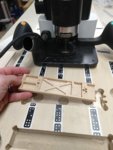Made my first ladder body and it turned out OK so far. Currently around 11 grams. It is 0.300" thick and the pockets are 0.250" deep, and will be stock BSA wheel locations. I'm going to make a stock-ish style car to enter in the adult division at our district race, just for fun to see how it runs on an aluminum track (our pack has wood).
However, I'm curious for feedback about those three holes in the rear axle cross beam. Those holes are for tuning weight with really small tungsten cylinders, but there's not much wall thickness. I guess I figured that gluing in the tungsten plates would stiffen it up, but now I'm not sure. Still have to drill the axle holes too.
Thanks!
However, I'm curious for feedback about those three holes in the rear axle cross beam. Those holes are for tuning weight with really small tungsten cylinders, but there's not much wall thickness. I guess I figured that gluing in the tungsten plates would stiffen it up, but now I'm not sure. Still have to drill the axle holes too.
Thanks!


